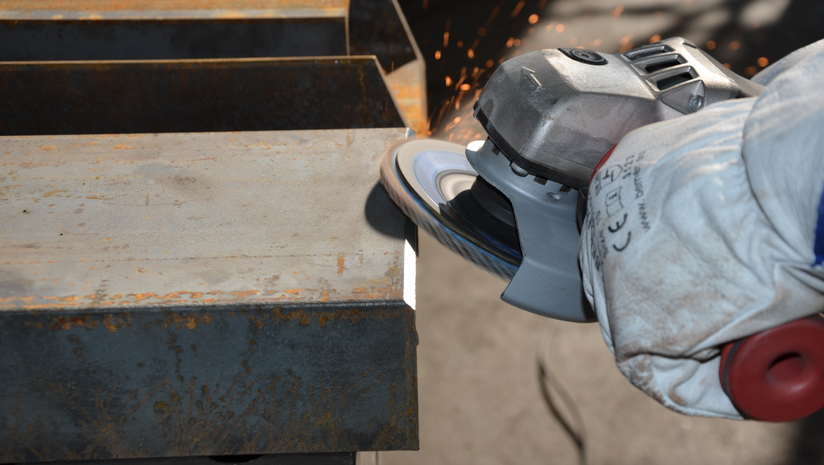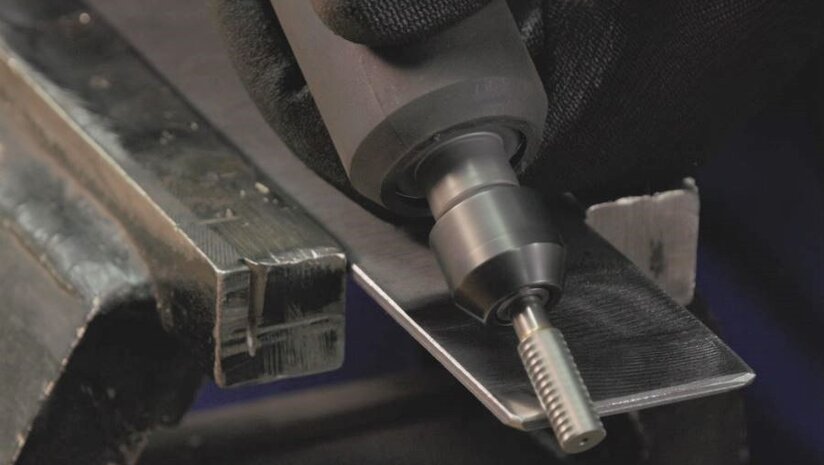
Beveling
If two workpieces are to be welded together, the edge of the workpieces must first be broken by a beveled surface. This is done by machining. The result is a chamfer, also known as a bevel.
What is beveling and
why is it important?
If two workpieces are to be welded together, the edge of the workpieces must first be broken by a beveled surface. This is done by machining. Or in other words, a space is created to accommodate the individual welding layers through which the workpieces are joined together. The bevel can have different shapes. The V-joint, the double V-joint, and the Y-joint are the most common shapes.
Which tool is used for beveling?
The position of the weld, the material of the workpiece, and the types of drives available - the choice of the right tool depends on various factors.
If an angle grinder is available, the beveling can be done with sulfur- and iron-free Osborn flap discs. Flap discs with a conical or straight shape are available. The angle on the workpiece determines the shape of the flap wheel.
If a workpiece made of non-ferrous metal is to be beveled, we recommend an abrasive cloth with a cooling bond as it reduces blue tarnish.

Pictured: Beveling with an Osborn flap disc.
If a straight grinder or air grinder is available, chamfering can be done with carbide burrs. The milling head is made of tungsten carbide-cobalt, the shank of tool steel. Different head shapes and toothings ensure that there is the right solution for every application.
For chamfering, burrs with cross serration (Z6) are the best choice. It ensures high stock removal in a short time. If the surface quality is important, a single tooth (Z3) is recommended. In the shipyard sector, the special shipyard toothing is often used. Compared to the Z6 toothing, it has a 30% higher material removal rate.

Camfering with a carbide burr.
Products for
Beveling.

Pink Liquid Color Compound
A full range of liquid polishing compounds that can be used individually or in combination to achieve a desired result. Liquid compounds are supplied in many variations of drums, totes, vats and gallon pails for manual and robotic operations. There is no one size fits all, Osborn prides itself on recommending the best, most efficient solution for every application.

White Liquid Cut Compound
A full range of liquid polishing compounds that can be used individually or in combination to achieve a desired result. Liquid compounds are supplied in many variations of drums, totes, vats and gallon pails for manual and robotic operations. There is no one size fits all, Osborn prides itself on recommending the best, most efficient solution for every application.

White Liquid Cut/Color Compound
A full range of liquid polishing compounds that can be used individually or in combination to achieve a desired result. Liquid compounds are supplied in many variations of drums, totes, vats and gallon pails for manual and robotic operations. There is no one size fits all, Osborn prides itself on recommending the best, most efficient solution for every application.

Tan Bar Color Compound
A full range of solid polishing compounds that can be used individually or in combination to achieve a desired result. All compounds are supplied in many variations and sizes for manual and robotic operations. There is no one size fits all, Osborn prides itself on recommending the best, most efficient solution for every application.

Green Bar Color Compound
A full range of solid polishing compounds that can be used individually or in combination to achieve a desired result. All compounds are supplied in many variations and sizes for manual and robotic operations. There is no one size fits all, Osborn prides itself on recommending the best, most efficient solution for every application.

Airway Bias Sisal Buff (BS)
A compact buff, purely made of sisal web. It is a hard, aggressive tool. Sisal is a natural material, perfect for the polishing process due its excellent compound retention properties.

Airway Open Double Cloth Bias Sisal (ODCBS)
A flexible and economical cutting tool with irregular folds of sandwiched sisal and cotton cloth quilted together. The quilting of the cloth and sisal provides flexibility in the buffing of contoured parts, and enables the buff to effectively hold compound. These buffs can produce an aggressive cut or color finish and adapt well to any surface.

Airway Open Bias Sisal Buff (OBS)
A flexible and economical cutting tool with irregular folds of sandwiched sisal. These buffs offer a heavy cutting action with the flexibility to use on flat or contoured surfaces.

Airway Cloth and Sisal Wavering Buff
The combination for dense sisal web and cotton cloth, folded in regular waves, results in a very hard cutting buff, ideal for removing oxidation or other first steps in the polishing process. A very useful tool if there is little or no oscillation.

Airway Polycotton Buff
Similar to the standard ventilated buffs this buff is flexible and versatile. This type of buff is constructed using the highest quality polycottons and is biased to reduce fraying and increase life. Various qualities of gray cloth can be selected depending on the results required. The irregular folds fixed to a metal clinch ring form a dense and economical buff for coloring.

Tan Grease Stick Compound
A full range of solid polishing grease sticks that can be used individually to achieve a desired result. All grease sticks are supplied in many variations and sizes for manual and robotic operations. There is no one size fits all, Osborn prides itself on recommending the best, most efficient solution for every application.

White Bar High Color Compound
A full range of solid polishing compounds that can be used individually or in combination to achieve a desired result. All compounds are supplied in many variations and sizes for manual and robotic operations. There is no one size fits all, Osborn prides itself on recommending the best, most efficient solution for every application.